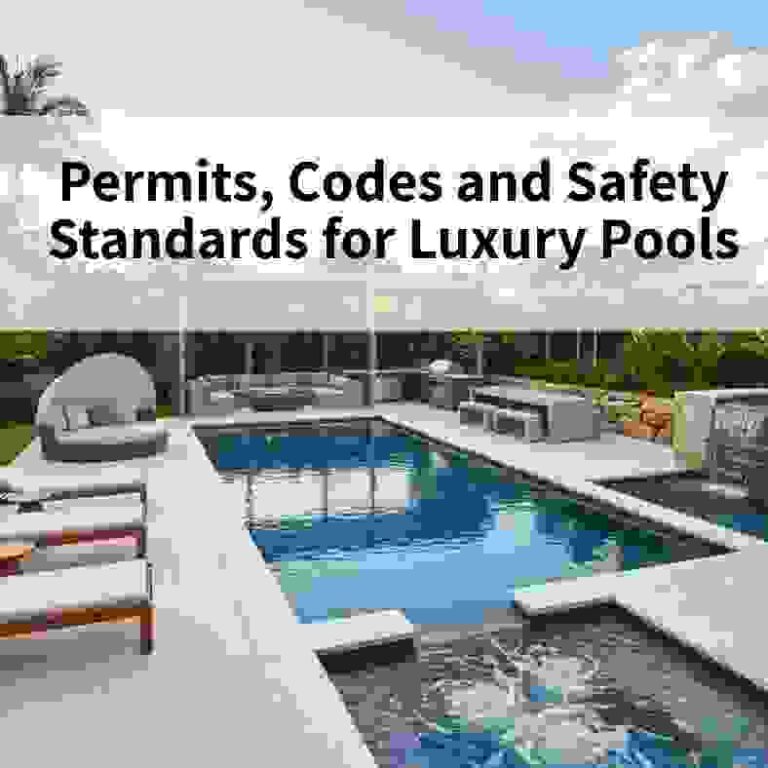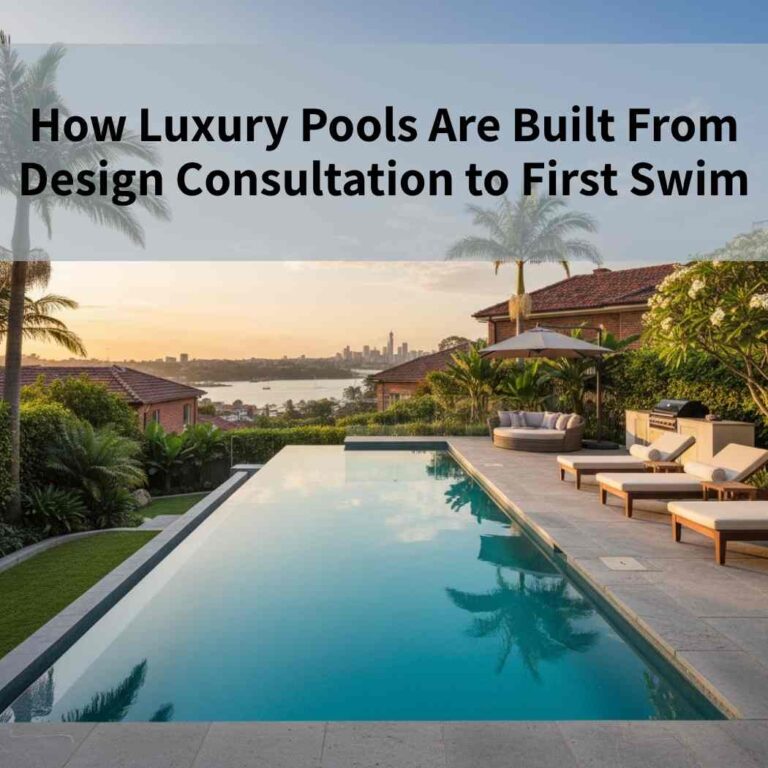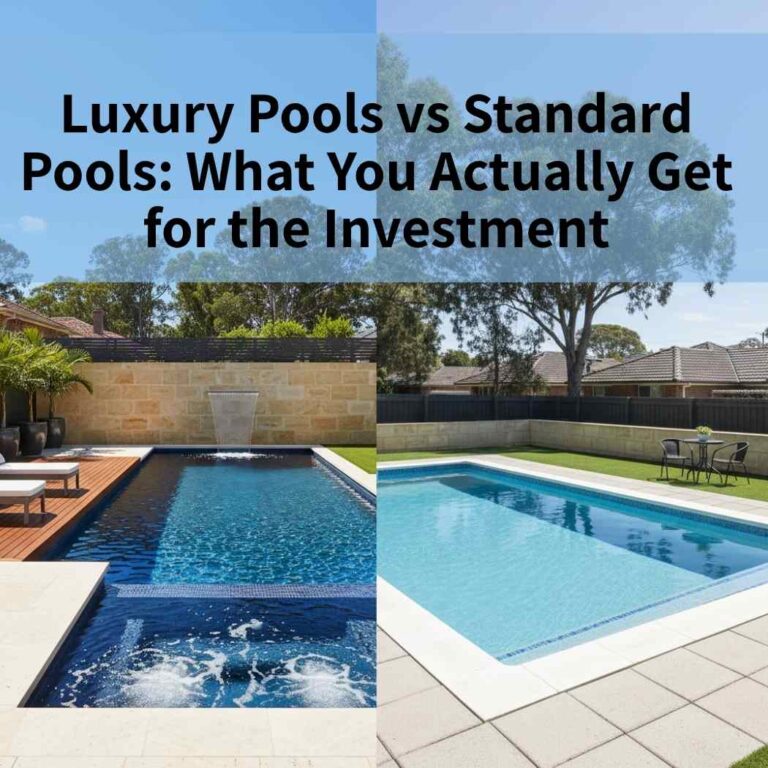Plunge Pool Cost Calculator Sydney
Estimate Your Plunge Pool Installation Cost in Sydney
Use our smart calculator to estimate the cost of installing a plunge pool tailored to your Sydney home. Adjust for pool type, size, features, materials and backyard conditions—all in one tool.
Estimate Your Plunge Pool Cost
Freshwater System
Ozone + Saltwater System
Pool Automation
In-Floor Cleaning
Frameless Glass Fencing
Pool Heating
What Factors Affect the Cost of Installing a Plunge Pool?
There are a lot of factors that influence how much it will cost to install a plunge pool. Before you speak to a pool builder, it’s worth thinking through what your ideal plunge pool looks like—so you can plan with clarity and avoid surprises.
Here are the factors to consider before building your dream pool:
Pool Size
Pool Material
Pool Type
Site Access
Interior Finish
Water Tiling
Add-On Spa
Pool Heating
Robotic Pool Cleaner
Chlorinator
Pool Fencing
- Permit Fees
- Decking
- Landscaping
Pool Size
There’s a simple rule when it comes to pool size: the bigger the plunge pool, the more it will cost.
Larger pools require more of everything—more concrete or fibreglass, more steel reinforcement, more excavation, and more soil removal. This directly increases the material and disposal costs. Bigger pools also take longer to build, which means higher labour costs.
Even when you’re opting for a precast plunge pool, a larger unit often means heavier machinery to install it and extra site preparation to support the weight and dimensions of the entire pool.
If you’re working with a small backyard, going compact won’t just save space—it could save you thousands. On the flip side, if you’re planning to use the pool for hydrotherapy, family use, or entertaining, investing in a slightly larger design may be worthwhile—but be prepared for a noticeable bump in the budget.
Pool Material
The material you choose for your plunge pool has a direct impact on cost, durability, and maintenance.
Precast Concrete Pools
These are built off-site and delivered as a ready-made shell. Installation is quick, often completed in just a few days, which saves on labour costs for your swimming pool.a Precast pools are ideal if you want a durable, stylish pool without the extended build time or disruption. While generally more affordable than custom concrete, they do come in standard sizes, which limits flexibility.Custom Concrete Pools
This is the most versatile option. You can shape and size it however you like, making it ideal for sloped blocks or tricky spaces. But with that flexibility comes higher costs—especially for labour, steelwork, waterproofing, and longer construction timelines. You’re paying for a tailored solution, and the price reflects that.Fibreglass Pools
These pools are pre-moulded and craned into place. They’re known for smooth surfaces, fast installation, and lower maintenance. However, they’re not always suitable for small or awkwardly shaped backyards, and the upfront cost can still be significant depending on size and brand.Installation is quick, often completed in just a few days, which saves on labour costs for your swimming pool.
Pool Type
The type of plunge pool you choose—above-ground, in-ground, or partially in-ground—significantly affects the total cost.
Above-ground plunge pools are often the most affordable option for a swimming pool. They require little to no excavation, which reduces labour, time, and machinery costs. Precast models can be craned into place with minimal site preparation, making them ideal for tight or sloped blocks where digging isn’t practical.
In-ground plunge pools, while more integrated into the landscape, usually come at a higher cost. Excavation, soil removal, and reinforcement all add to the budget. However, they often offer a more seamless look and may increase property value.
Partially in-ground plunge pools offer a balance of aesthetics and affordability. The cost depends on how much of the swimming pool is below ground level and the level of retaining or structural support needed. They’re popular for sloping backyards where a full in-ground pool would require heavy excavation.
Site Access
Site access is often overlooked—but it can make or break your budget.
If your property is hard to access, expect the cost to rise. Tight entry points, sloped blocks, or backyard obstructions may prevent standard machinery like excavators and bobcats from entering. In some cases, equipment must be craned over buildings—adding thousands in logistics and hire fees.
Even basic tasks like soil removal or concrete pouring become more complex and time-consuming when access is limited for your swimming pool installation.
Interior finish
The internal surface of your pool doesn’t just affect how it looks—it also impacts price.
A basic concrete finish is the most budget-friendly option, but many homeowners opt for premium finishes like pebblecrete or beadcrete. These textured surfaces not only look better, but they also last longer and provide better grip underfoot.
However, the price varies depending on the colour and type of finish you choose. Designer shades and blended textures can increase material costs and require more precise application—adding to labour time.
Waterline Tiling
Waterline tiling is a small detail that makes a big visual impact.
While not essential, it gives your plunge pool a high-end look and helps reduce staining around the waterline. The cost depends on how much of the pool is tiled, the tile quality, and the pattern complexity.
Mosaic tiles, for example, are labour-intensive and can drive up installation time and cost.
Robotic Pool Cleaner
A robotic cleaner isn’t mandatory—but it’s a smart investment if you want less maintenance.
Leading models like the Dolphin S200 by Maytronics are highly effective and user-friendly, with prices around $2,000. They clean the floor, walls, and waterline, saving you hours of manual scrubbing.
While it’s an upfront cost, a robotic cleaner helps preserve your pool’s finish and water quality over time.
Chlorinator
The chlorination system you choose affects both the upfront cost and long-term pool care.
Traditional chlorine systems don’t need a chlorinator, which makes them the cheapest to install. However, most Australian homeowners prefer saltwater or mineral pools for their gentler feel and lower chemical use, making them an efficient choice for a swimming pool. These systems do require a chlorinator, pushing the cost up slightly.
If you’re going for a magnesium or mineral pool, make sure you choose a compatible chlorinator designed for mineral use—these tend to be more expensive but offer added health and skin benefits.
Pool Fencing
Fencing isn’t just a design choice—it’s a legal requirement in Australia.
The cost depends on the type of fence you install. Frameless glass fencing is sleek, modern, and perfect for showing off your plunge pool, but it’s also the most expensive. Aluminium or mesh fencing is more affordable but may not match your desired aesthetic for your swimming pool area.
Either way, fencing must comply with local pool safety regulations, which may require self-closing gates, minimum heights, and specific materials—so be sure to factor this into your budget.
Permit Fees
Installing a plunge pool isn’t just about digging a hole and filling it with water—it needs to be done legally.
Every pool in Australia requires council permits and building approvals, which vary depending on your location, the pool size, and proximity to boundaries or other structures. These fees can range from a few hundred to several thousand dollars, especially if extra documentation—like engineering reports or soil testing—is required.
Delays in approval can also hold up your project, so it’s smart to factor both time and cost into your planning early.
Decking
Decking adds both function and flair to your plunge pool—but it can quickly become one of the more expensive extras.
Whether you choose timber, composite, or stone, decking improves safety, creates a comfortable walk zone, and enhances the overall aesthetic. Materials like spotted gum or modwood are popular for their durability and weather resistance, but come with different price points.
The final cost depends on the deck size, the materials used, and the complexity of the build (e.g. multi-level decking or custom edging). And don’t forget—decking around your swimming pool often needs maintenance, especially timber options in humid or coastal areas.
Landscaping
Landscaping transforms your plunge pool from a water feature into a backyard retreat.
Plants, pavers, garden lighting, privacy screens, retaining walls—these design elements complete the space and improve usability. But landscaping can add thousands to your budget, depending on the scale of the work and the materials you choose.
A simple gravel and turf finish might cost a few hundred dollars, while premium options like tropical gardens, mood lighting, and architectural stone paths can stretch well into the five figures.
It’s best to treat landscaping as part of the total project cost—not an afterthought—so your pool area feels complete from day one.
How Much Do Plunge Pools Cost in Sydney?
The cost of a plunge pool in Sydney depends on several factors—such as size, materials, site access, and additional features like heating or decking.
For small plunge pools, the prices in Sydney typically start at around $40,000 when conditions are ideal. This would usually include a basic precast or in-ground pool with minimal excavation and good site access.
However, if your block is sloped, access is tight, or you’re after a custom finish or luxury upgrades like tiling, spa jets, or solar heating, the price can increase quickly—often reaching $50,000 to $70,000+ for more complex projects.
For more detailed breakdown of these costs, check out our full guide: How Much Does a Plunge Pool Cost in Sydney?
How Can I Reduce the Installation Cost of my Plunge Pool?
Reducing the cost of installing a plunge pool comes down to smart planning and knowing where you can simplify without sacrificing quality. Here are a few practical ways to cut costs:
Choose a Smaller Pool Size
Smaller plunge pools require less material, labour, and space—making them much more budget-friendly, especially in compact backyards.Go for a Precast Option
Precast concrete pools are built off-site and installed in days, reducing both build time and labour expenses compared to custom in-ground pools.Keep the Design Simple
Avoid complex shapes, custom finishes, or curved walls that require extra formwork. A clean, rectangular design is cheaper and still looks great.Limit Add-Ons
While features like heating, spa jets, and custom lighting are nice, they can quickly add up. Start with the essentials and add extras later if needed.Improve Site Access
Make sure your site is easy for machinery to access. Tight access can require cranes or manual labour, which pushes up costs.Take Care of Landscaping Separately
You can stage your project by installing the pool first, then handling decking and landscaping as your budget allows. DIY landscaping can also help save money.Handle Some Tasks Yourself
If you’re comfortable, managing permits, basic site prep, or finishing touches (like fencing or lighting) can reduce contractor fees.
By following these steps can definitely help reduce your pool build costs. But the smartest move? Have an open conversation with your chosen plunge pool builder. They can guide you through cost-saving options that won’t compromise on quality—and tailor recommendations based on your site, design, and budget.
Ready to Build Your Dream Pool?
From council approvals to finish installations, we create backyard spaces that feel like home.
Whether you’re stuck on permits, or imagining the perfect swimming pool for your backyard, we’ve got you covered from start to finish. Contact us to start your dream swimming pool or select a design that suits your needs.
Call Us Today!
Call us on the number above for a quote ont your swimming pool project.
Servicing Central & South Sydney
Can’t find your area? Give us a call on 02 9072 1128 to find out if we cover your area, too!




